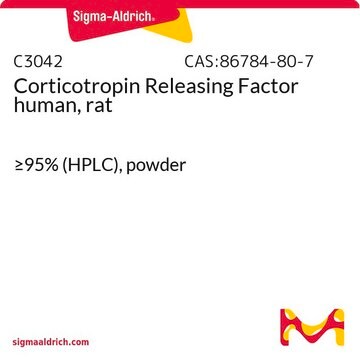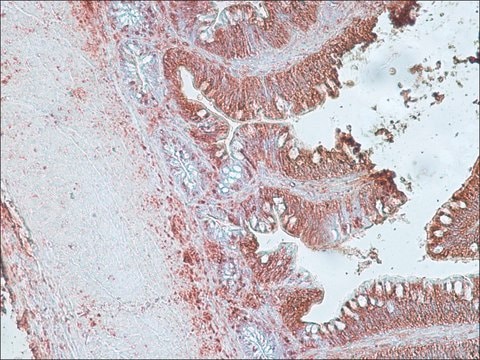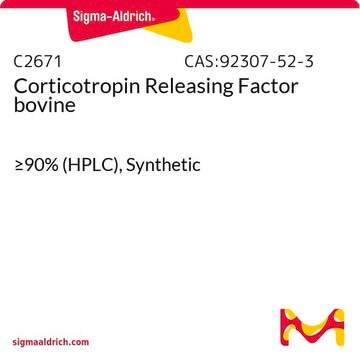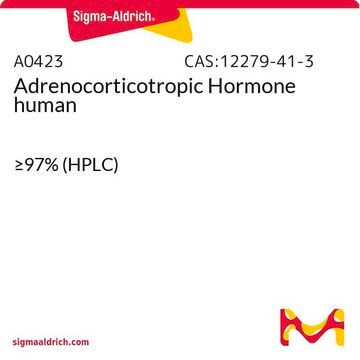05-23-0050
Corticotropin Releasing Factor, Human and Rat
An immunomodulatory neuropeptide that acts to release ACTH from the anterior pituitary and stimulates the sympathetic nervous system and adrenal medulla.
Synonym(s):
Corticotropin Releasing Factor, Human and Rat, CRF, CRH, Corticotropin-releasing hormone
About This Item
Recommended Products
Quality Level
Assay
≥97% (HPLC)
form
lyophilized solid
manufacturer/tradename
Calbiochem®
storage condition
OK to freeze
desiccated (hygroscopic)
technique(s)
cell based assay: suitable
color
white to off-white
solubility
5% NH4OH: 1 mg/mL (prepared with H₂O)
shipped in
ambient
storage temp.
−20°C
InChI key
VXFVFWFSJFSXHN-FAUHKOHMSA-N
Gene Information
human ... CRH(1392)
General description
Corticotropin-releasing factor (CRF), a 41-amino-acid peptide, is widely expressed in neurons throughout the mammalian brain and several peripheral tissues such as the pancreas, stomach, and small intestine. It functions by stimulating the secretion of corticotropin in the anterior pituitary, which in turn regulates adrenal cortex synthetic/secretory activity. Human CRF is located on chromosome 8q13 and is identical to rat and mouse CRF. It assumes a random coil structure under physiological conditions and α-helix shape in an amphiphilic environment.
Application
Biochem/physiol Actions
Primary Target: An immunomodulatory neuropeptide
The product does not compete with ATP.
Reversible: no
Corticotropin-releasing factor (CRF), a neuropeptide also known as corticotropin-releasing factor (CRH), plays a crucial role in the stress response by activating the hypothalamic-pituitary-adrenal (HPA) axis and extrahypothalamic pathways. It acts by releasing Adrenocorticotropic Hormone (ACTH) from the anterior pituitary, stimulating the sympathetic nervous system and adrenal medulla. Besides its involvement in stress regulation, CRF peptides have diverse effects on both, the central nervous system and peripheral tissues. This includes potential regulation of anxiety, mood, feeding, inflammation, gastric emptying, and blood pressure. Aberrant secretion of CRF could potentially contribute to the development of various neuropsychiatric disorders such as anxiety, depression, obsessive-compulsive disorder, Parkinson′s disease, Alzheimer′s disease, alcohol withdrawal, and post traumatic stress disorder. Also, CRF and CRF-R1 (Corticotropin-Releasing Factor Receptor 1) have been observed in lymphoid organs and sites of inflammation, suggesting a role in immune system regulation.
Packaging
Warning
Sequence
Physical form
Reconstitution
Other Notes
Wei, E.T., et al. 1993. Ciba Found. Symp. 172, 258.
Smith, E.M., et al. 1986. Nature321, 881.
Udelsman, R., et al. 1986. Nature319, 147.
Legal Information
Storage Class Code
11 - Combustible Solids
WGK
WGK 3
Flash Point(F)
Not applicable
Flash Point(C)
Not applicable
Certificates of Analysis (COA)
Search for Certificates of Analysis (COA) by entering the products Lot/Batch Number. Lot and Batch Numbers can be found on a product’s label following the words ‘Lot’ or ‘Batch’.
Already Own This Product?
Find documentation for the products that you have recently purchased in the Document Library.
Our team of scientists has experience in all areas of research including Life Science, Material Science, Chemical Synthesis, Chromatography, Analytical and many others.
Contact Technical Service








